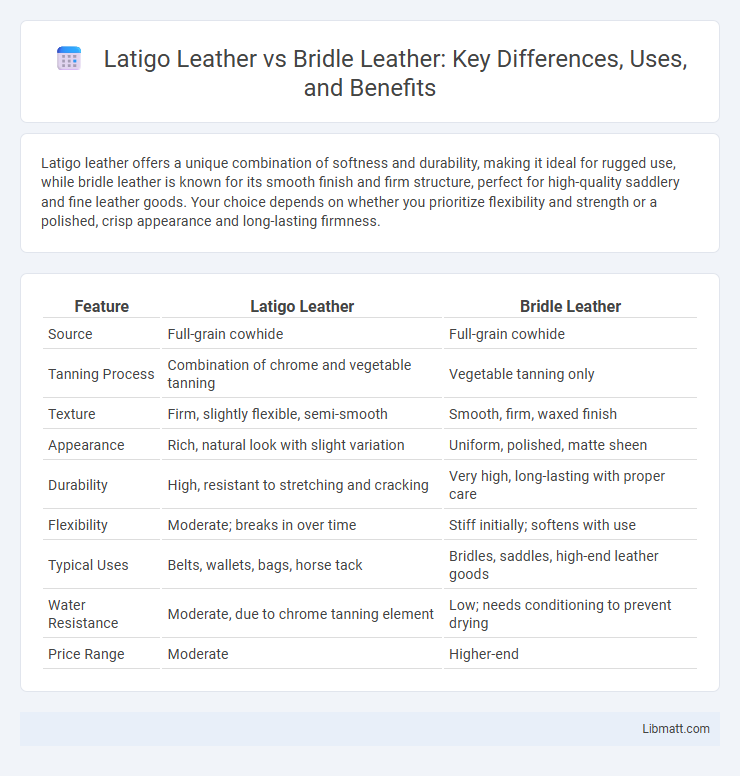Latigo leather offers a unique combination of softness and durability, making it ideal for rugged use, while bridle leather is known for its smooth finish and firm structure, perfect for high-quality saddlery and fine leather goods. Your choice depends on whether you prioritize flexibility and strength or a polished, crisp appearance and long-lasting firmness.
Table of Comparison
| Feature | Latigo Leather | Bridle Leather |
|---|---|---|
| Source | Full-grain cowhide | Full-grain cowhide |
| Tanning Process | Combination of chrome and vegetable tanning | Vegetable tanning only |
| Texture | Firm, slightly flexible, semi-smooth | Smooth, firm, waxed finish |
| Appearance | Rich, natural look with slight variation | Uniform, polished, matte sheen |
| Durability | High, resistant to stretching and cracking | Very high, long-lasting with proper care |
| Flexibility | Moderate; breaks in over time | Stiff initially; softens with use |
| Typical Uses | Belts, wallets, bags, horse tack | Bridles, saddles, high-end leather goods |
| Water Resistance | Moderate, due to chrome tanning element | Low; needs conditioning to prevent drying |
| Price Range | Moderate | Higher-end |
Introduction to Latigo and Bridle Leather
Latigo leather is a durable, flexible material commonly used in western saddlery and belts, known for its unique combination of chrome and vegetable tanning processes. Bridle leather, traditionally vegetable-tanned, offers a smooth, firm, and polished finish ideal for high-quality harnesses and leather goods. Understanding the differences between Latigo and Bridle leather helps you select the right leather type for your specific crafting or riding needs.
What is Latigo Leather?
Latigo leather is a high-quality, full-grain leather known for its durability and flexibility, made through a unique tanning process that combines chrome and vegetable tanning methods. It features a smooth, supple texture with a slight wax finish, providing resistance to water and wear, making it popular for belts, bags, and saddlery. Compared to bridle leather, Latigo offers a softer hand feel while maintaining excellent strength and longevity.
What is Bridle Leather?
Bridle leather is a high-quality, vegetable-tanned leather known for its durability and smooth, firm texture, commonly used in equestrian gear like bridles and harnesses. It undergoes a meticulous process of oiling and waxing, enhancing its water resistance and longevity while developing a rich patina over time. This type of leather offers superior strength and flexibility compared to Latigo leather, making it ideal for heavy-duty applications requiring both toughness and comfort.
Tanning Process: Latigo vs Bridle
Latigo leather undergoes a combination tanning process that includes both chrome and vegetable tanning, resulting in a flexible yet durable hide ideal for saddles and belts. Bridle leather is primarily vegetable-tanned, which enhances its firmness and ability to absorb oils, making it perfect for straps and harnesses requiring strength and longevity. Understanding these tanning distinctions helps you choose the right leather based on the balance between softness and structural integrity in your project.
Key Differences in Durability
Latigo leather offers exceptional durability due to its combination of chrome and vegetable tanning, resulting in a flexible yet robust material ideal for heavy use. Bridle leather, tanned traditionally with vegetable oils, provides superior strength and develops a rich patina over time, enhancing its longevity and resistance to wear. Both leathers withstand rigorous conditions, but Latigo leather tends to be more resistant to water and stretching, while bridle leather excels in toughness and stiffness for structured applications.
Flexibility and Stiffness Compared
Latigo leather offers a unique balance of flexibility and stiffness, providing a supple feel while maintaining durability, making it ideal for items requiring some bend but with strong hold. Bridle leather is traditionally stiffer and firmer due to its vegetable tanning and hot-stuffing process, resulting in excellent structural integrity and long-lasting support. Your choice depends on whether you prefer the soft adaptability of Latigo or the rigid strength of Bridle leather for your project.
Common Uses of Latigo Leather
Latigo leather is commonly used for making durable belts, saddles, and straps due to its strong, flexible, and water-resistant qualities. Your choice of latigo leather ensures long-lasting performance in heavy-use items like harnesses and rugged outdoor gear. Its combination of strength and pliability makes it especially suited for equestrian equipment and wallets that require both toughness and a smooth finish.
Common Uses of Bridle Leather
Bridle leather is commonly used for equestrian tack such as bridles, reins, and harnesses due to its durability and smooth finish. It is favored in crafting belts, wallets, and high-quality leather goods that require strength and flexibility. Its natural oils and waxes ensure long-lasting wear, making it ideal for items subjected to frequent use and stress.
Maintenance and Care Tips
Latigo leather requires regular cleaning with saddle soap and conditioning with a leather conditioner to maintain its softness and flexibility, preventing cracking and drying. Bridle leather benefits from routine cleaning and conditioning with neatsfoot oil or leather balm to preserve its smooth finish and firmness, ensuring longevity and resistance to moisture. Both types should be stored in a cool, dry place away from direct sunlight to avoid damage and discoloration.
Which Leather Should You Choose?
Latigo leather offers flexibility and a soft finish ideal for casual leather goods, while bridle leather provides firm structure and durability suited for high-quality saddlery and belts. You should choose Latigo leather if you want a supple texture that develops a rich patina over time, whereas bridle leather is better for items requiring strength and a polished appearance. Consider your project's needs for softness versus rigidity to determine the best leather type.
Latigo leather vs bridle leather Infographic

 libmatt.com
libmatt.com